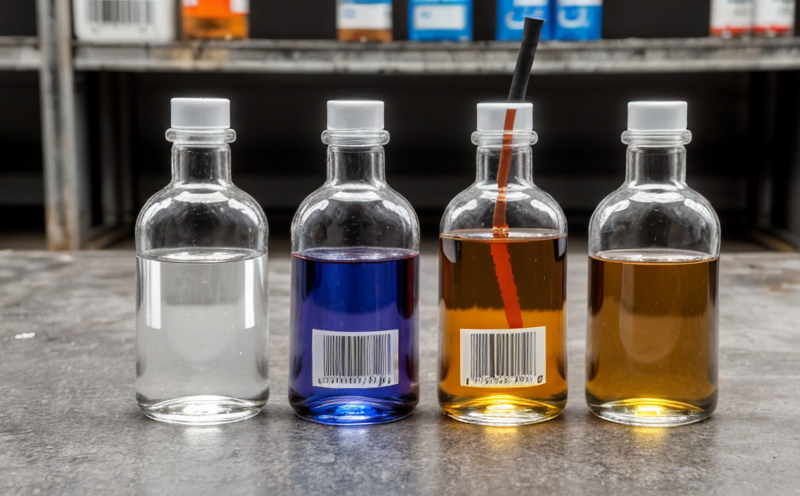EN ISO 16474 Artificial Weathering Stability Testing of Paints and Varnishes
The EN ISO 16474 standard specifies the procedure for determining the artificial weathering stability of paints and varnishes. This testing method is crucial in ensuring product quality, durability, and performance over time. It helps manufacturers understand how their products will behave under real-world conditions before they are exposed to actual environmental stresses.
The test simulates various types of exposure that a product might experience during its lifecycle, such as ultraviolet light (UV), heat, humidity, and water. By subjecting the paint or varnish specimens to these simulated environments, laboratories can assess the material's resistance to fading, cracking, peeling, and other forms of degradation.
The testing process is conducted in a controlled environment where specific parameters are meticulously maintained. These include temperature, relative humidity, wavelength of light used for UV exposure, and duration of each condition. The specimens are exposed to these conditions over an extended period, typically several weeks or months depending on the desired results.
Specimen preparation is critical to achieving accurate test outcomes. Prior to testing, samples must be prepared according to ISO standards to ensure consistency across all tests. This includes ensuring that the sample size and shape are appropriate for the testing apparatus used.
The artificial weathering stability test is performed using specialized equipment designed to replicate natural environmental conditions as closely as possible. Common pieces of equipment include UV lamps, humidity chambers, and temperature-controlled ovens. The specimens are exposed to these elements in a sequential manner or simultaneously, depending on the specific requirements of the standard.
The results from this testing method provide valuable insights into how well the paint or varnish can withstand exposure to environmental factors. These findings are essential for quality managers and compliance officers looking to ensure their products meet regulatory standards and consumer expectations.
For R&D engineers, understanding these test parameters is crucial when developing new formulations that aim to improve weather resistance. The data obtained from this testing method helps in refining recipes, selecting appropriate raw materials, and optimizing manufacturing processes.
The information provided by the EN ISO 16474 test is also beneficial for procurement teams who need to select suppliers whose products will perform reliably under challenging conditions. By knowing the results of such tests, they can make informed decisions about which vendors to partner with based on their product's durability and longevity.
Key Parameters
- Temperature: Typically between 50°C and 85°C depending on the specific standard being followed.
- Relative Humidity: Can vary but often starts at around 20% RH to simulate dry climates, rising up to 100% RH for humid conditions.
- UV Light Wavelengths: Most commonly 315 nm to 400 nm, which corresponds to the visible and near-UV regions of sunlight.
- Durability Time: Varies from a few days up to several months depending on the exposure conditions chosen by the laboratory.
The test results are reported in terms of the physical properties retained after exposure. These include color change, gloss retention, adhesion strength, and other relevant metrics. Compliance officers can use these reports to ensure that their products meet all necessary regulatory requirements regarding durability and longevity.
Benefits
- Predictive Performance: Identifies potential issues early in the product development cycle, allowing for improvements before launch.
- Enhanced Durability: Ensures that products can withstand harsh environmental conditions, leading to increased customer satisfaction and loyalty.
- Regulatory Compliance: Helps manufacturers meet international standards and regulations related to product durability and performance.
- Data-Driven Decisions: Provides reliable data for decision-making regarding material selection, formulation adjustments, and process optimizations.
Why Choose This Test
The EN ISO 16474 test is essential for several reasons. Firstly, it offers a standardized approach to evaluating the artificial weathering stability of paints and varnishes, ensuring consistent results across different laboratories. Secondly, its comprehensive nature allows for thorough examination of various aspects affecting product performance over time.
Moreover, this testing method aligns closely with international standards like ISO 16474-1 and ASTM D6530, which are widely accepted by regulatory bodies worldwide. This alignment enhances the credibility and acceptance of test results in global markets.
For quality managers, choosing this test ensures that their products meet rigorous quality assurance criteria, thereby enhancing brand reputation and trust among consumers. Compliance officers find value in its ability to verify adherence to relevant regulations, reducing risks associated with non-compliance penalties.
In summary, the EN ISO 16474 artificial weathering stability testing offers a robust framework for assessing paint and varnish durability under simulated environmental conditions. Its precision and reliability make it an indispensable tool in modern quality assurance practices.
International Acceptance and Recognition
The EN ISO 16474 standard is recognized internationally for its stringent requirements and rigorous methodology. It has been adopted by numerous countries as a means to ensure consistent quality in paints and varnishes.
Many nations have incorporated this standard into their national standards or guidelines, further emphasizing its importance within the industry. This widespread acceptance enhances the global marketability of products tested using this method because consumers trust brands that adhere to internationally recognized standards.
Organizations involved in certification processes often require compliance with EN ISO 16474 as part of their qualification criteria. This requirement adds another layer of assurance for businesses seeking to enter new markets or expand existing ones.
The international recognition extends beyond mere acceptance; it fosters collaboration between different regions, promoting best practices and innovation across borders. Laboratories accredited according to this standard are trusted partners in developing high-quality materials that stand up against the test of time.





